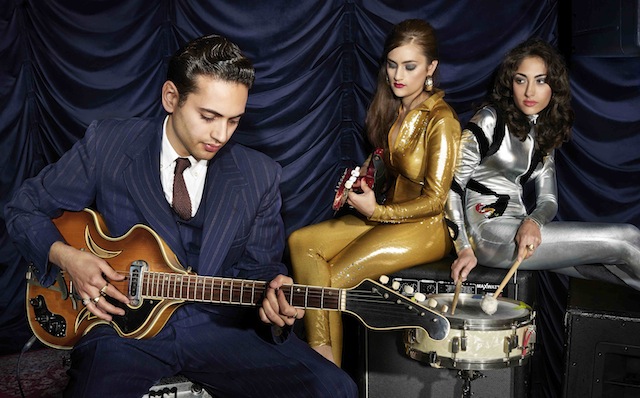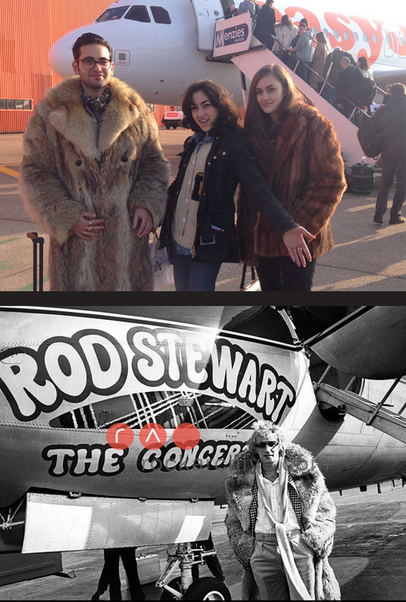Kitty, Daisy, and Lewis shot by Dean Chalkey.
Squeezed between a raggedy nail parlor and a shuttered up florist on a particularly scrubby bit of North London’s Kentish Town Road, sits a needle in the urban hay. Painted British racing green and accented with gold flourishes is Phonographic Devices, the DIY, analogue recording studio owned by three nattily dressed siblings.Now in their early 20s, the trio have been performing together as Kitty, Daisy and Lewis for well over a decade, playing a back to basics concoction of classic rock ‘n’ roll, skiffle, blues and soul. Their latest album, Kitty, Daisy & Lewis - The Third was the first to be recorded in the new studio, with production help from music legend and close family friend, The Clash and Big Audio Dynamite’s Mick Jones.On a freezing winter’s day, Noisey met the whole gang at the cozy, cluttered studio—formerly an Indian restaurant called the Dehli Diner. Stepping over assorted vintage amps, classic guitars, and two gorgeous silver greyhounds, and with Lewis on hand to supply cups of tea, we gathered around a single heater to talk about the family hearse, Rod Stewart’s fur coat, Al Capone’s accessories, and the continued destruction of some of London’s most treasured live music venues.Noisey: So how far do you all actually go back?Mick Jones:I met Daisy (oldest sibling), just before she was born! Their dad’s a mastering engineer and at the time we were cutting a Big Audio Dynamite record—it was 1988. He got a call halfway through the session and he had to rush to the hospital, because Daisy was being born…Kitty: He didn’t go straight away though, did he? Mum was like, “My waters have broken,” and he was like, “Wait a minute, I’m just doing the b-side…”Mick: I came back into the picture a few years ago and we became reacquainted. During the time that we were making this record, it was Daisy’s birthday, so it was almost like this record’s been 26 years in the making. It was Notting Hill Carnival at 2013, and I was standing backstage at Gaz’s (Rocking Blues soundsystem) just chilling and Lewis came up and said, “Do you fancy producing us?” and I didn’t hesitate. We went to the India Club on the Stand to talk about it, which is a very old colonial restaurant and social club—it’s very old fashioned. We had a nice curry.
Why did you want to work on the record?
Mick: Because I knew how talented they were. They come from a fantastically musical family. It was meant to be.When did you come into the studio?
Lewis: Well the first time we showed Mick the studio, the floor was here, but there wasn’t much of anything else.Mick: It was just a gutter!So how did you go about turning an old restaurant into the studio?
Daisy: It was completely derelict when we got it and had been closed for 15 years. Our dad remembered it though and apparently Chuck Berry ate here once.Kitty: But they left in a hurry and left everything behind. There was rotting food and freezers with maggots in, there were foxes living here, it was infested with pigeons. There was shit everywhere—cockroaches, rats, the lot. Everything disgusting you can think of, it was here. It took about three years to convert it.Mick: Their dad’s got a hearse that they use to move stuff around. It’s like the Addams family.Kitty: We got that before we started using vans, because you can fit a double bass and keyboard in it.Lewis: They’re quite cheap—or they were when dad got it—because no-one else wanted them. We gutted the back and put a bench seat in. People do the sign of the cross when you drive past.Daisy: There was talk of getting a taxi, but it ended up being a hearse.How long did it take to record the new album?
Lewis: The recording only took two months, the mixing took longer.Mick: One of the tape machines set on fire, but that was only a minor thing. Lewis is great at electronics, so there was a lot of soldering. Overnight he’d be fixing stuff. It was beautiful thing to see the making of it—all of that is forgotten in modern recording. You’re playing Viva Las Vegas in April and it’s the biggest event on the rockabilly calendar and everyone dresses the hell up. Have you started planning your outfits yet?
You’re playing Viva Las Vegas in April and it’s the biggest event on the rockabilly calendar and everyone dresses the hell up. Have you started planning your outfits yet?
Kitty: Me and Daisy have been making jumpsuits which we wear onstage, we make them with our mum. It’s really hand for female drummers, as you can imagine. They’re really comfy, it’s kind of almost like wearing your PJs, but they look cool too. Our mum’s got one pattern for each of us and we keep reusing it.How important is the look of the band?
Kitty: You’re putting on a show, so you don’t want to look like shit.Lewis: As long as you don’t look like the audience, you’re alright.Mick: My old manager used to say, “If the audience looks better than you, why would they like you?”Lewis you recently acquired Rod Stewart’s 1970s wolf skin coat. How did you get your hands on that?
Lewis: I know an ex-engineer from Olympic Studios, which was in Barnes, where Rod recorded. I had a tape machine from Liam Watson at Toerag which came from Pye Studios originally, which he wanted to restore. He said I’ll swap you for Rod’s wolf skin coat. He had originally got it off another engineer and he swapped his motorcycle for it back in the old days. Private jet versus Easyjet.What’s everyone’s most treasured item of clothing?
Private jet versus Easyjet.What’s everyone’s most treasured item of clothing?
Kitty: I’ve got a fur coat which my great-grandmother made.Lewis: They were tailors in the East End and originally came from Romania… Mine are my long johns. When I haven’t got them on, something feels wrong.Mick: I’ve got Al Capone’s tie. It belonged to his brother Ralph. My mum lives in America and she’s friendly with Ralph Capone’s widow. He was famous in prohibition times for doing the mixers—he did the Coca-Cola and the ginger ale, so he was known as “Bottles.” I’m keeping it in my cupboard. I haven’t worn it out. It’s red silk, it’s a beautiful tie.Have you kept onto much of your stuff from 1970s and 1980s?
Mick: I’ve got quite a few bits—jackets and shirts. Long johns! It’s funny, because in the “Rock The Casbah” video, I didn’t want to wear all that military gear—I wanted to wear these pink salmon long johns. I liked this film The Ballad of Cable Hogue with Jason Robards. It’s a Sam Peckinpah film and in it, he mostly wears these salmon pink long johns with hobnail boots and a cowboy hat. I wanted to do that, so I’m having a mood in the video. I did get to wear them under my shirt for the bit where I’m standing in the swimming pool, smoking a guitar, but blink and you’ll miss them.The band grew up in this area—how much has Camden changed since you were younger?
Daisy: It has changed a hell of a lot – for the worse. You used to get a lot more individual stalls and shops and now every shop’s selling pretty much the same thing.Lewis: It’s all changed. When I used to go down there they’d be lots of different people selling independent stuff and old junk and you knew the people. But a lot of that’s gone now, and it’s just people selling knock-off Clash t-shirts! There’s a song about that on the album, called Developers Disease.Mick: The Clash used to have our studio on Chalk Farm Road, in the Stables. In those days it wasn’t a market at all. The first album artwork was photographed there. It was desolate British Rail buildings. We had that studio from ’76 to 1980. It was just pubs and cafes and Compendium Books, which was an alternative, counter-culture bookshop. It was old fashioned—the start of punk was closer to the end of the World War II than we are now to the start of punk. I grew up on bombsites where you still smell the bombs, the cordite.A spate of small London venues have closed recently—the 12 Bar, Madame Jo-Jos, Buffalo Bar. Should people be worried?
Kitty: Definitely. I don’t think enough people are aware of it and some just don’t care. It’s just really sad that these places are going and they’re legendary joints. They’re beautiful buildings as well. There’s an old pub up the road from here that used to be called The Castle, then it was the Bullet Bar and The Flowerpot—there’s been a pub on that site since the 1600s and they’re been trying to knock it down for a few years now.Mick: Same with the 12 Bar, that’s from the 17th century and they’re just knocking it down. That’s a stupid idea what they’ve got for Tottenham Court Road—it’s a massive development done by people who have no sense of a community. That’s what we need, another big shopping mall!Kitty, Daisy & Lewis Tour Dates March 26 - Crocodile Cafe - Seattle, WA
March 27 - Doug Fir Lounge - Portland, OR
March 28 - WOW Hall - Eugene, OR
March 29 - Hopmonk Tavern - Sebastopol, CA
March 31 - Belly Up - Solana Beach, CA*
April 1 - The Independent - San Francisco, CA*
April 3 - El Rey Theatre - Los Angeles, CA*
April 4 - Viva Las Vegas Festival - Las Vegas, NV*
April 6 - Bluebird Theater - Denver, CO*
April 7 - The Waiting Room - Omaha, NE*
April 8 - Turf Club - St. Paul, MN*
April 9 - Lincoln Hall - Chicago, IL*
April 10 - The Magic Bag - Ferndale, MI*
April 14 - Bowery Ballroom - New York, NY*
April 15 - World Cafe Live - Philadelphia, PA*
April 16 - The Sinclair - Cambridge, MA*
April 17 - U Street Music Hall - Washington, DC*
April 19 - 3rd & Lindsley - Nashville, TN
* = w/ opener Gemma RayKitty, Daisy & Lewis - The Third will be released on 3.31 via Sunday Best Recordings.Leonie Cooper is a fabulous and she's on Twitter.
Advertisement
Mick: Because I knew how talented they were. They come from a fantastically musical family. It was meant to be.
Advertisement
Lewis: Well the first time we showed Mick the studio, the floor was here, but there wasn’t much of anything else.Mick: It was just a gutter!So how did you go about turning an old restaurant into the studio?
Daisy: It was completely derelict when we got it and had been closed for 15 years. Our dad remembered it though and apparently Chuck Berry ate here once.Kitty: But they left in a hurry and left everything behind. There was rotting food and freezers with maggots in, there were foxes living here, it was infested with pigeons. There was shit everywhere—cockroaches, rats, the lot. Everything disgusting you can think of, it was here. It took about three years to convert it.Mick: Their dad’s got a hearse that they use to move stuff around. It’s like the Addams family.Kitty: We got that before we started using vans, because you can fit a double bass and keyboard in it.Lewis: They’re quite cheap—or they were when dad got it—because no-one else wanted them. We gutted the back and put a bench seat in. People do the sign of the cross when you drive past.Daisy: There was talk of getting a taxi, but it ended up being a hearse.How long did it take to record the new album?
Lewis: The recording only took two months, the mixing took longer.Mick: One of the tape machines set on fire, but that was only a minor thing. Lewis is great at electronics, so there was a lot of soldering. Overnight he’d be fixing stuff. It was beautiful thing to see the making of it—all of that is forgotten in modern recording.
Advertisement

Kitty: Me and Daisy have been making jumpsuits which we wear onstage, we make them with our mum. It’s really hand for female drummers, as you can imagine. They’re really comfy, it’s kind of almost like wearing your PJs, but they look cool too. Our mum’s got one pattern for each of us and we keep reusing it.How important is the look of the band?
Kitty: You’re putting on a show, so you don’t want to look like shit.Lewis: As long as you don’t look like the audience, you’re alright.Mick: My old manager used to say, “If the audience looks better than you, why would they like you?”Lewis you recently acquired Rod Stewart’s 1970s wolf skin coat. How did you get your hands on that?
Lewis: I know an ex-engineer from Olympic Studios, which was in Barnes, where Rod recorded. I had a tape machine from Liam Watson at Toerag which came from Pye Studios originally, which he wanted to restore. He said I’ll swap you for Rod’s wolf skin coat. He had originally got it off another engineer and he swapped his motorcycle for it back in the old days.

Kitty: I’ve got a fur coat which my great-grandmother made.Lewis: They were tailors in the East End and originally came from Romania… Mine are my long johns. When I haven’t got them on, something feels wrong.
Advertisement
Mick: I’ve got quite a few bits—jackets and shirts. Long johns! It’s funny, because in the “Rock The Casbah” video, I didn’t want to wear all that military gear—I wanted to wear these pink salmon long johns. I liked this film The Ballad of Cable Hogue with Jason Robards. It’s a Sam Peckinpah film and in it, he mostly wears these salmon pink long johns with hobnail boots and a cowboy hat. I wanted to do that, so I’m having a mood in the video. I did get to wear them under my shirt for the bit where I’m standing in the swimming pool, smoking a guitar, but blink and you’ll miss them.The band grew up in this area—how much has Camden changed since you were younger?
Daisy: It has changed a hell of a lot – for the worse. You used to get a lot more individual stalls and shops and now every shop’s selling pretty much the same thing.Lewis: It’s all changed. When I used to go down there they’d be lots of different people selling independent stuff and old junk and you knew the people. But a lot of that’s gone now, and it’s just people selling knock-off Clash t-shirts! There’s a song about that on the album, called Developers Disease.
Advertisement
Kitty: Definitely. I don’t think enough people are aware of it and some just don’t care. It’s just really sad that these places are going and they’re legendary joints. They’re beautiful buildings as well. There’s an old pub up the road from here that used to be called The Castle, then it was the Bullet Bar and The Flowerpot—there’s been a pub on that site since the 1600s and they’re been trying to knock it down for a few years now.Mick: Same with the 12 Bar, that’s from the 17th century and they’re just knocking it down. That’s a stupid idea what they’ve got for Tottenham Court Road—it’s a massive development done by people who have no sense of a community. That’s what we need, another big shopping mall!Kitty, Daisy & Lewis Tour Dates March 26 - Crocodile Cafe - Seattle, WA
March 27 - Doug Fir Lounge - Portland, OR
March 28 - WOW Hall - Eugene, OR
March 29 - Hopmonk Tavern - Sebastopol, CA
March 31 - Belly Up - Solana Beach, CA*
April 1 - The Independent - San Francisco, CA*
April 3 - El Rey Theatre - Los Angeles, CA*
April 4 - Viva Las Vegas Festival - Las Vegas, NV*
April 6 - Bluebird Theater - Denver, CO*
April 7 - The Waiting Room - Omaha, NE*
April 8 - Turf Club - St. Paul, MN*
April 9 - Lincoln Hall - Chicago, IL*
April 10 - The Magic Bag - Ferndale, MI*
April 14 - Bowery Ballroom - New York, NY*
April 15 - World Cafe Live - Philadelphia, PA*
April 16 - The Sinclair - Cambridge, MA*
April 17 - U Street Music Hall - Washington, DC*
April 19 - 3rd & Lindsley - Nashville, TN
* = w/ opener Gemma RayKitty, Daisy & Lewis - The Third will be released on 3.31 via Sunday Best Recordings.Leonie Cooper is a fabulous and she's on Twitter.
